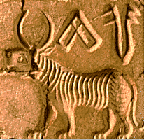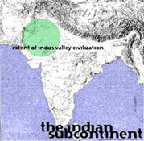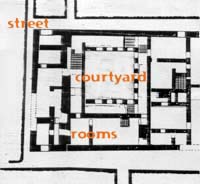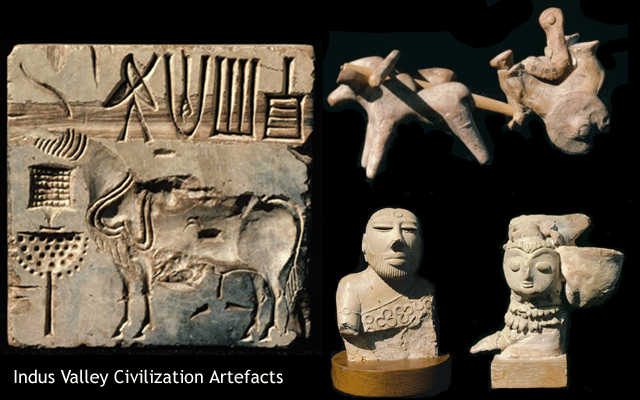Jan 07, 2026
Jan 07, 2026
 The Indus Valley Civilization, or the Harappan Culture, formed the earliest urban civilization on the Indian sub-continent, and one of the earliest in the world. Its unique urban characteristics ensure it a place in the annals of world architecture. However, before discussing these, it is worthwhile to briefly examine the history of its discovery.
The Indus Valley Civilization, or the Harappan Culture, formed the earliest urban civilization on the Indian sub-continent, and one of the earliest in the world. Its unique urban characteristics ensure it a place in the annals of world architecture. However, before discussing these, it is worthwhile to briefly examine the history of its discovery.
Archaeologists were always puzzled by Vedic texts (dated c.1500 - 900 BC) that talked about "nomadic invaders conquering mighty citadels …under the banner of their God, Indra ..."* . However, no trace of the 'mighty citadels' had ever been found, nor of their mysterious inhabitants, the Dasas.
Then, in 1856, six miles from the river Ravi, in the foothills of the Himalayas, railway construction workers came upon a small crumbling hill of fire-baked bricks. These they quickly appropriated for the railway line's ballast. Along with the bricks, certain steatite (soapstone) seals were found. Archaeologists, notably Sir John Cunningham, quickly confirmed their antiquity. Thus started a voyage of amazing discovery during which archaeologists unearthed the remains of an ancient civilization, which had its epicenter in the plains of the Indus.
However, settlements were found as far west as Baluchistan in Pakistan and well down into the Gangetic plain in India. New discoveries are still being made. The main cities are Mohenjo-daro and Harappa, both in modern-day Pakistan.
The Land of the Gods
 What were the origins of the Indus Valley people? Some 5000 years ago, a nomadic people made their way into northwest India from Sumeria (modern day Iran) by means of the Mula Pass across the Himalayas, near modern Karachi, and there found a fabulously rich land, fertilized by the great river systems of the Indus, Ravi, Beas, Chenab and Sutlej. This same area forms modern-day Punjab. Compared to the deserts of Iran, this was God's blessed land, with ample water, fodder and fuel supply. Clay for making bricks was plentiful in the riverbeds and so was wood to burn the bricks.
What were the origins of the Indus Valley people? Some 5000 years ago, a nomadic people made their way into northwest India from Sumeria (modern day Iran) by means of the Mula Pass across the Himalayas, near modern Karachi, and there found a fabulously rich land, fertilized by the great river systems of the Indus, Ravi, Beas, Chenab and Sutlej. This same area forms modern-day Punjab. Compared to the deserts of Iran, this was God's blessed land, with ample water, fodder and fuel supply. Clay for making bricks was plentiful in the riverbeds and so was wood to burn the bricks.
Over a period of a thousand years, these immigrants spread over an area of half a million square miles.
Architecture and Town Planning
If by 'urban' we mean the tendency to form society, founding cities with all their attendant rules, then the Harappan people succeeded admirably. Excavations show a degree of urban planning which the Romans achieved only later, after a gap of 2500 years.
The twin cities of Mohenjo-daro and Harappa formed the hub of the civilization. They are representative in the sense that planning principles employed here are followed practically without change at all other sites. Both cities were a mile square, with defensive outer walls. An orthogonal street layout was oriented toward the cardinal directions. The street layout shows an understanding of the basic principles of traffic, with rounded corners to allow the turning of carts easily. These streets divided the city into 12 blocks. Except for the west-central blocks, the basic unit of city planning was the individual house.
 The Harappan house is an amazing example of a native people, without the benefit of technology, adapting to local conditions and intuitively producing an architecture eminently suited to the climate. The house was planned as a series of rooms opening on to a central courtyard. This courtyard served the multiple functions of lighting the rooms, acting as a heat absorber in summer and radiator in winter, as well as providing an open space inside for community activities. There were no openings toward the main street, thus ensuring privacy for the residents. In fact, the only openings in the houses are rather small - this prevented the hot summer sun heating the insides of the houses.
The Harappan house is an amazing example of a native people, without the benefit of technology, adapting to local conditions and intuitively producing an architecture eminently suited to the climate. The house was planned as a series of rooms opening on to a central courtyard. This courtyard served the multiple functions of lighting the rooms, acting as a heat absorber in summer and radiator in winter, as well as providing an open space inside for community activities. There were no openings toward the main street, thus ensuring privacy for the residents. In fact, the only openings in the houses are rather small - this prevented the hot summer sun heating the insides of the houses.
An advanced drainage system is also in evidence. Drains started from the bathrooms of the houses and joined the main sewer in the street, which was covered by brick slabs or corbelled brick arches, depending on its width.
 In most of the sites, the central-western blocks were reserved for public architecture. Perhaps the most famous examples are the Great Bath and Granary at Mohenjo-daro. The Great Bath has been the subject of much debate over its exact function. The prevalent view seems to be that it was used for ritualistic bathing - much as continues in the Hindu tradition even today.
In most of the sites, the central-western blocks were reserved for public architecture. Perhaps the most famous examples are the Great Bath and Granary at Mohenjo-daro. The Great Bath has been the subject of much debate over its exact function. The prevalent view seems to be that it was used for ritualistic bathing - much as continues in the Hindu tradition even today.
 It is unfortunate that none of the structures of the Indus Valley civilization survive intact today. Unlike Egypt and Mesopotamia, the Harappan people left nothing monumental, like the pyramids or ziggurats, for posterity to marvel at. This may be the reason that among the majority of books on architecture, the Harappan Culture hardly merits a note. However, the planning principles and response of the architecture to climate are a lesson to us all.
It is unfortunate that none of the structures of the Indus Valley civilization survive intact today. Unlike Egypt and Mesopotamia, the Harappan people left nothing monumental, like the pyramids or ziggurats, for posterity to marvel at. This may be the reason that among the majority of books on architecture, the Harappan Culture hardly merits a note. However, the planning principles and response of the architecture to climate are a lesson to us all.
Artifacts for Posterity
 The most numerous of the surviving artifacts are a series of steatite (soapstone) seals, of which the best known are those of the Humped Brahmani Bull and Pashupati. Apart from this, there are some carved figurines - the bronze Dancing Girl and the statues of a priest and a male torso, again in steatite.
The most numerous of the surviving artifacts are a series of steatite (soapstone) seals, of which the best known are those of the Humped Brahmani Bull and Pashupati. Apart from this, there are some carved figurines - the bronze Dancing Girl and the statues of a priest and a male torso, again in steatite.

Decline and Decay
The peaceful life of the Harappan people bred a sense of complacency. Hence, when the Aryan invaders poured in from the Northwest, they encountered little or no resistance. City after city fell, and the pathetic remains of the people were either assimilated into the conquerors' way of life, or fled further south. In fact, the fall of Mohenjo-daro, almost 3,500 years ago, typified this decay.
In terms of achievements in town planning and civil administration, this was a great setback, as more than a thousand years were to pass before anything of this magnitude was accomplished in India again.
The invaders were a nomadic people, unused to urban life. They revered all natural phenomena, ascribing divinity to animals, the wind, the trees, the sky and the water, among myriads of others. It was during this age that the Vedas began to be composed - this formed the basis of early Hinduism.
The culture and architecture of these early nomads is the focus of our next article: The Vedic Age.
A concise History of Indian Art, Craven, Roy C., Praeger Publishers, New York, 1976.
21-Dec-2000
More by : Ashish Nangia

|
ITS A GOOD INFORMATIVE ART |

|
i would like to suggest dat if we could more information on burial during harrapa civilization ,it will be great useful to us otherwise its superb..... |

|
It's useful for all students |

|
this is very useful for all student &scholar of archaeology. |

|
i am very much interested to know more about the Indus valley civilization. |

|
excelent siteeeeeeee |

|
Where can I get a picture of an ancient Indus/Harapan calender? |

|
vree good arts |

|
Equally unfortunate that Shankar Kashyap's own website quotes the following: "Matriya, a rogue Avestan Magus, decides to penetrate deep into Bharata and perform a yajna ritual to gain power to control nature and divert the mighty river Sindhu (Indus) into his country of Ariana using. He gets help from a Meluhhan traitor. The Avestan king, Vishtaspa marches on Harappa with a powerful army of 15000 soldiers, high speed chariots and talented cavalry accompanied by his Magi." It seems that Shankar Kashyap too subscribes in fiction to a theory of invasion, helped along by 'magic'. I stand by this article until and unless new theories, which are only emerging, are conclusively proved by rigorous scientific debate. |

|
Unfortunate that the author still clings on to the aryan invasion theory despite no real evidence of any invasion or plenty of evidence to the contrary. The IVC declined mainly because of natural disasters and tectonic activity in the region. There were several earthquakes and disastrous floods during the end of third millennium BCE and beginning of second. |

|
The twin cities od mohenjo-daro and harappa hub of civilization written about the planning principals employed, are very interesting for reference to compare with present day Urban Planning, I hope you will permit me to give reference of your observations in my efforts to write about in the book on city planning. Thanks Yours sincerely K.K.Arora |

|
Very Good & Useful site for all people |

|
this site is very good and very interesting and useful |

|
nothing to say just got the best |

|
good |

|
excellent site |

|
Informative |